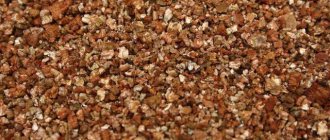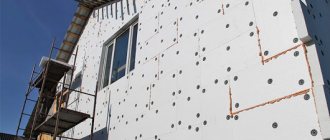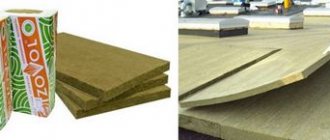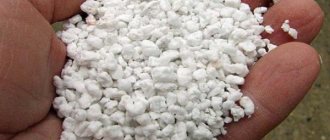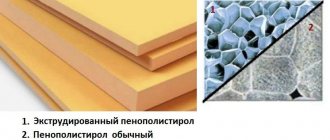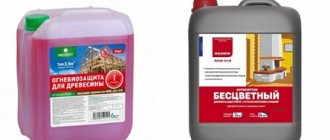Despite the emergence of new, more convenient to use thermal insulation materials, glass wool is still considered one of the most common insulation materials. In its origin and structure, it is a type of mineral wool. Glass wool is an insulation material obtained from waste from the glass industry, is inexpensive and is widely used in construction.
One of the most popular thermal insulation materials
But there are some nuances to using glass wool.
There are cases when, after a year or two, a wall insulated with glass wool began to freeze.
There are also situations when water flows from an intact roof. All these are reasons for the wrong choice of material and poor-quality installation.
I would like to draw your attention to the fact that not all contractors understand these simple issues.
So, let’s look at the basic principles for choosing a brand of glass wool from a particular manufacturer.
Then we will consider an important rule when installing any fiber insulation (glass wool, stone wool), which will allow us to avoid the above problems
To ensure that glass staple fiber does not deform during its service life, it is important that the density of the material is chosen correctly. The fact is that density affects the strength characteristics
And they determine whether the wool will retain its shape in the structure or slide off in a year or two.
It is important to understand that glass staple fiber will warm your home if it fits tightly to the load-bearing wall along the entire perimeter. But, on the other hand, you can’t press cotton wool against the wall.
We will not go into the nuances of heating engineering, but we will understand the main thing: the thermal conductivity coefficient of the insulation and its thickness are important. No matter how many times the thickness of the insulation is smaller, approximately the same time it retains heat worse. That is, if you doubled the glass wool in the structure, you approximately doubled the thermal performance of the wall or roof. Yes, now it won’t slip, but the heating will be much worse.
The most common cotton wool sold in the retail network is rolls with a density of 11 kg/m3: URSA GEO Light, KNAUF Insulation Thermo Roll 040, ISOVER Classic. Turkish and Chinese wool in mats supplied to the Russian market, as a rule, also have a density of 11 kg/m3.
This type of glass wool is intended for horizontal non-load-bearing structures: insulation and sound insulation of floor slabs, floors along joists, insulation of horizontal non-load-bearing roofs.
For insulation of walls and for attic roofs with a slope, glass wool with such a density is undesirable.
I would like to note that URSA, Isover and Knauf Insulation do everything so that the consumer does not pay attention to the density of their material. With the goal that they cannot be compared head-on with cheaper Turkish and Chinese counterparts.
Of course, if you follow the recommendations of URSA, Isover and Knauf Insulation when choosing a brand of insulation for a particular application, then everything will work as expected. In this case, you don’t have to worry about the density of the material. The main rule is to choose the brand where your design is indicated in the area of application.
If you want to save money and take glass wool from other manufacturers, then you should know that for pitched roofs, partitions, and wall insulation from the inside, you should use wool with a density of 15 kg/m3 and higher.
For layered masonry, it is better to use material with a density of 20 kg/m3. Of course, for myself I would use glass wool with a density of 30 kg/m3. I would like to note that stone wool of the same density will not work as reliably in a three-layer wall and layered masonry, unlike glass wool.
Glass wool is very popular for external wall insulation. In this case, it is worth taking glass staple fiber with a density of at least 30 kg/m3. It is better if the wool is cached with fiberglass. Fiberglass will provide additional strength and protect the fibers from blowing out.
Floor insulation
Floor insulation has always been a separate issue. What is better – glass wool or expanded clay? Each of these materials has its own pros and cons, so the final choice largely depends on the specific situation. In particular, it depends on the expected maximum thickness of the insulation and the available budget.
However, based on a combination of factors, it can be argued that expanded clay is better. It holds deformation loads well and is also not at all interesting to mice. Glass wool guarantees you problems on both the first and second points.
Effect on humans
Working with glass wool
The disadvantage of glass wool is the increased fragility of the fibers, sharp and thin fragments of which easily penetrate clothing (from which they are difficult to remove) and further into the skin, causing itching. Inhaling air containing debris from glass wool fibers can cause long-term irritation to the lungs because they exit the lungs very slowly. It is also dangerous for glass wool fibers to get into your eyes.
To prevent these phenomena, work with glass wool should be carried out in thick protective clothing that does not leave exposed areas of the body, canvas gloves, safety glasses and a respirator.
First aid for vitreous lesions
If glass wool gets on your skin, you should never itch it, as this will only drive the debris into the skin. Try to gently shake the glass wool out of your hair by placing your head in a bathtub (without water), closing your eyes and shaking your head. Take a cold shower with strong water pressure without detergents. Do not rub the skin with washcloths, sponges, or use hot water, as it dilates the pores of the skin. After taking a shower, do not dry yourself with a towel.
Wait until your body is dry and take a cold shower again, this time with soap. If glass wool gets into your eyes, rinse them with a strong stream of cold water. If irritation does not go away, immediately contact an ophthalmologist, preferably an eye surgery clinic, or call an ambulance. If you inhale broken glass wool fibers, if you have persistent coughing, difficulty breathing, etc., consult a doctor immediately. It is better to throw away clothes contaminated with glass wool. Even careful repeated washing does not completely guarantee the removal of fibers.
Roof insulation based on "Ursa - pitched roof"
Thermal insulation for pitched roofs, produced by a German company using URSA Spannfilz technology, is widely used in the construction of all kinds of construction, both residential and non-residential buildings.
Insulation URSAGlasswool Pitched roof
Advantages of this insulation:
- the elasticity of this insulation allows it to be held in the spaces between the beams without sagging and the formation of cracks;
- lightness of insulation;
- presence of soundproofing characteristics;
- low thermal conductivity – 0.036 W/m×K;
- excellent flexibility of the insulation, which allows you to fill difficult spaces;
- there is no need for additional fastening elements, it is held in the openings by itself;
- under the packaging the insulation is compressed 5 times, and after unpacking it quickly returns to its volume;
- the material practically does not burn.
Prices for URSA Pitched Roof insulation depend on the size of the mats and start at 50 USD. for 1 cubic meter. The thickness of the material is 150 and 200 mm, but the most popular are mats with a thickness of 150 mm. As a rule, this thickness is always enough to insulate pitched roofs in most cases. When calculating the thickness of insulation for a specific climate zone, you will have to use the SNiP 11-3-79 guide. The material is produced with a width of 1200 mm, with a length from 3900 to 4200 mm. It fits seamlessly between the roof rafter system without joints or gaps.
Technical characteristics of glass wool
The thermal conductivity of glass wool is 0.039-0.05 W/m*K. The heat insulator in glass wool is the air itself, which fills the cavities formed between the weaves of fibers. It can be operated at temperatures up to 450 degrees.
Insulation properties:
- low thermal conductivity;
- good sound insulation characteristics;
- non-flammability;
- elasticity and compressibility;
- ease and simplicity of installation;
- durability.
Mineral wool: types and materials
According to GOST (state standard), there are three types of mineral wool:
- Stone wool. This type of mineral wool is made from basalt, diabase, dolomite and limestone.
- Slag wool. The raw material for this type of material is blast furnace metallurgy waste.
- Glass wool. This type of mineral wool is made from broken glass, or from sand, limestone and soda.
The quality and characteristics of any type of mineral wool depend (except on the raw material) on the length and thickness of the fiber. The exact composition is usually kept secret - each manufacturer tries to create a material with the best performance characteristics, selecting the percentage of components, while not forgetting to minimize costs. Therefore, the same type of insulation from different manufacturers can have a significant difference in characteristics and even in cost.
Due to its low price, glass wool was widespread a few decades ago. But working with this material is very, very difficult - small, sharp fibers penetrate into the smallest pores. Therefore, when working with glass wool, disposable thick clothing is required (no processing makes it possible to remove the remains of glass fibers from the fabric), protective gloves, goggles, and a respirator.
When working with glass wool, be sure to wear a respirator, gloves and disposable protective clothing.
It happens that when a bath is insulated with polystyrene foam, mice infest it. As for glass wool, it is unlikely that mice will have the desire to chew on glass.
It is much easier to work with stone and slag wool - they are not so caustic and do not irritate the skin and mucous membranes, although a protective mask and gloves will not be superfluous. Recent studies indicate that formaldehyde is released from mineral wool, which is used as a binding element. Therefore, during prolonged contacts indoors, it is recommended to use protective masks or respirators.
Although none of the studies conducted has yet definitively proven the negative effects of mineral wool, depending on their composition, they are classified in the world classification:
- To safety group 3 (there is no evidence of carcinogenic effects) all types except wool made from ceramic fibers and glass wool made from discontinuous fibers.
- Group 2 includes glass wool made from discontinuous glass fibers and mineral wool made from fire-resistant ceramic fibers. For them there is confirmed data on the carcinogenic danger to animals.
You can work with slag and stone wool without protective clothing, but a respirator and gloves will not be superfluous. Therefore, when choosing materials, it is advisable to choose trusted manufacturers who control the level of formaldehyde resins in their products (usually indicated on the packaging).
Does mineral wool burn: research, conclusions, real cases
Whether mineral wool burns is of interest to everyone who has chosen this material for insulating buildings, because the fire safety of the building depends on how fire-resistant the insulation is. The class of mineral wools includes slag wool, stone wool and glass wool. The appearance, structure, scope and installation technology of these insulation materials are similar, but the characteristics differ, including in terms of fire resistance. Whether stone, glass or slag wool burns or not in the event of a fire can be determined based on the composition of these materials and the properties of their components.
Conclusions and research
In terms of fire safety class, non-combustible mineral wool belongs to the NG group, although the fire resistance limits of insulation materials made from different raw materials vary. In the production of mineral heat insulators, polymers are often used to serve as a binder. They are highly flammable formaldehyde resins.
Organic additives impair the fire resistance of the material, but the degree of their influence on the flammability of the material is exaggerated. The polymer content in mineral wool does not exceed a few percent if the insulation is produced by a reputable manufacturer.
Thermal insulation, in the production of which bentonite clays are used as a binder, has a lesser ability to support combustion. The combustion temperature of mineral wool in this case can be +1000°C. The fire resistance of slag wool is limited to +250°C, and that of glass wool is limited to +450°C.
Basalt insulation is the most fireproof material. Their advantage over other mineral heat insulators has been confirmed by experiments conducted by Rockwool specialists. The test methodology was developed based on GOST 30403-2012.
You can check whether stone wool burns at home. Repeated experiments in which attempts were made to set mineral thermal insulation slabs on fire using gas welding equipment,
showed its high resistance to fire.
Certificates
Often mineral heat insulators are produced not according to GOST, but according to TU. The fire resistance of mineral wool must be confirmed by a certificate. When purchasing a heat insulator, you need to carefully read the characteristics indicated on the packaging. The certificate must indicate the product’s compliance with the fire safety requirements established in NPB 244-97 and the flammability class (NG, G1, G2, etc.) in accordance with GOST and SNiP. Mineral wool produced according to technical specifications must also comply with state standards.
Real cases of fires in buildings with mineral wool
Fires in buildings insulated with mineral wool occur frequently, and insulation does not prevent the spread of fire. The reason for this may be the poor quality of the material. Mineral wool is often covered with cladding that does not meet fire hazard requirements, and the flammability of the insulation in these cases increases. This is also facilitated by gluing mineral wool to surfaces with compounds with low fire resistance.
A fire with a fire area of 1.5 thousand m² occurred in Moscow. It took more than 1.5 hours to extinguish it. The fire was caused by the ignition of a heat insulator. Welding work on the roof of the Rublev shopping center in Irkutsk caused a fire in the mineral insulation. The fire area was only 20 m², but more than 100 visitors had to be evacuated from the shopping center. In the Kaliningrad region, a fire crew went to extinguish the insulation of a heating main: the fire spread to mineral wool from grass burning near the pipeline.
Does glass wool burn?
Glass wool, like other types of mineral thermal insulation, does not burn on its own. Fire can only result from an increase in its temperature above the fire resistance limits of the material. When used in compliance with safety requirements, glass wool will not cause a fire, so it is better to insulate surfaces that are not subject to strong heating with it. The use of glass wool for thermal insulation of chimneys, etc. should be abandoned.
What is the safest insulation
Ursa PureOne – formaldehyde-free, acrylic based.
There is no point in determining which insulation is safe for health among natural materials, so only modern insulation of artificial origin should be considered. The most used thermal insulation materials:
- mineral wool;
- Styrofoam;
- polyurethane foam.
Typically, the manufacturers of each of the materials presented above claim that their insulation is safe for health. In fact, this is true, and disputes regarding the safety of a particular material revolve mainly around the components from which the insulation is made. It is also important how the insulation behaves under different operating conditions. For example, polystyrene foam is harmful as insulation if it is heated. During the process of melting or burning, it emits toxic gases, just like polyurethane foam. PPU is nothing more than a modified polystyrene foam, its improved descendant, so to speak.
If we consider the components of which insulation are absolutely safe for health, then you cannot find better mineral wool from Ursa from the PureOne line:
- made from quartz sand;
- does not contain formaldehyde - acrylic-based binder;
- soft fibers that do not break or create dust;
- does not irritate the skin - the color and texture is similar to cotton.
In addition, this material does not burn and can withstand temperatures above 800 degrees, which significantly expands the scope of its application.
Health effects of fiberglass
In 1997, studies were conducted in Europe on the effects of mineral wool on human health. The criteria by which they examined mineral wool were: fiber size, the presence of oxides and alkali metals in the composition.
Mineral wool should have been classified into the second or third hazard class. The second class of hazard involves the presence of irritating substances and the presence of dangerous irritants. The third class of hazard means that the availability of data on the composition does not allow a thorough verification of the harmfulness of the product.
Only in 2001, the result of a study of mineral wool on the analysis of carcinogenic substances was presented to the public. It was classified in the third class, that is, not causing diseases in the human body.
Harm of glass wool to the lungs
Small particles of glass wool can get into a person's lungs. The health hazard from glass wool is characterized by the fact that the composition contains mineral particles and phenol resins, which are added to hold these particles together.
If glass wool is used in an enclosed area, particles and toxic phenol are released into the air, which are inhaled by the lungs of people present there.
Harmful microparticles are not removed from the lungs for a long time, and can cause:
- allergic reaction in the form of a dry cough;
- shortness of breath;
- respiratory diseases that become chronic.
It's a fact: people who deal with glass wool are at risk for lung cancer.
Pulmonologist D. Vinogradov, associate professor of the 1st Moscow State Medical University named after. Sechenov notes that microparticles can cause various dermatoses, chronic and obstructive bronchitis, against this background there is the possibility of developing bacterial and fungal infections.
You need to know: indoor plants help bind mineral dust. Carpets and all sorts of soft toys are dust collectors. When cleaning a room with glass wool insulation elements, it is recommended to use a washing vacuum cleaner or install an air humidifier in the room
Manufacturing technology
Glass wool production
The starting materials for the production of glass wool are sand, soda, dolomite, limestone, borax (or etibor). Modern production uses up to 80% cullet.
The main components are poured into the bunker. Next comes the stage of melting the mass. Dosers load the melting furnace in strict accordance with the recipe so that when the temperature reaches 1400 °C the mixture has the specified mechanical properties to obtain the finest threads. The threads are produced by blowing molten glass from a centrifuge with steam.
The fiber formation process is accompanied by treatment with polymer aerosols. Aqueous solutions of phenol-aldehyde polymer modified with urea are used as a binder. The aerosol-impregnated thread falls onto the rollers. On the conveyor it goes through several stages of leveling. A homogeneous glass-polymer “carpet” is formed. Next comes the polymerization stage at a temperature of 250 °C. High temperature is a catalyst for the formation of polymer bonds. At the same time, the remaining moisture obtained with the aerosol evaporates in the temperature chamber. After polymerization, the cotton wool becomes hard and acquires an amber-yellow hue.
The next stage is cooling, where the glass wool is cooled to ambient temperature, after which it is sent for cutting. Longitudinal cutters and cross-cut saws cut the endless strip into mats and rolls.
The resulting insulation has a large volume, since it is completely permeated with air. Pressing finished products allows you to significantly save space during transportation and storage. According to European standards, sixfold compression is provided. The elastic properties of thermal insulation are sufficient to completely restore the original dimensions.
Criteria for choosing glass wool
When planning to purchase this insulation, keep in mind certain nuances so that the glass wool is of high quality and lasts as long as possible:
- First of all, pay attention to the packaging in which the insulator is stored. It must be strong and intact. It is highly recommended not to expose the material to atmospheric moisture or sunlight during storage.
- High-quality material has a light yellow color and a uniform structure.
- Consider the density and thickness of glass wool. Most common?
Dependence on the density of the material and the location of insulation
A material with a certain density has a specific purpose. Thus, basalt insulation with a density of 25-30 kg/m3 is intended for thermal insulation of floors. He should not experience any stress on himself. 35 kg/m3 is used for the roof, 45 kg/m3 can be installed vertically. Materials with a density of 50-60 kg/m3 are used in layered installation, and 70-80 kg/m3 are installed in ventilated facades.
For plaster facades it is necessary to purchase slabs with a density of 140-150 kg/m3, and for flat roofs with a load - 160-180 kg/m3.
When choosing a material, you should take into account that the denser the insulation, the higher its price, since more raw materials were spent for production. But at the same time they have the same thermal characteristics.
https://youtube.com/watch?v=4MLsqSnjaw8%3F
The use of organic insulation
Glass wool is, first of all, a thermal insulation material. It is used in the construction of residential and industrial buildings as heat, wind, steam and sound insulation.
Glass wool insulation is used:
- For insulation of vertical, horizontal and inclined structures in buildings of any type.
- On external surfaces with mandatory plastering.
- In suspended ventilated facades.
- In fences: on the inside or inside three-layer sandwich panels with metal sheathing, concrete or reinforced concrete panels.
- In multi-layer coverings of flat roofs it is used as a lower or upper heat and sound insulating layer without covering with a cement screed.
- In frame buildings, for example, bathhouses, for insulating walls and ceilings.
- At metallurgical, petrochemical and other enterprises for insulation of main oil and gas pipelines, pipelines and reservoirs of heating networks, industrial equipment and process pipelines.
What to choose – basalt wool or glass wool?
In the building materials market, mineral insulation materials account for ½ of the total sales of products in this category. Their advantages over organic-based insulation materials have ensured their popularity and high rating in the field of construction work. The most common types of insulation are glass wool and stone wool (basalt wool).
Today we will tell you about the properties of these products, the pros and cons of their use, and which insulation is best suited for a particular type of construction.
Glass wool
The starting material for these products is broken glass (80%), natural sand, limestone, borax, dolomite. The raw material, melted at a temperature of 1500 degrees, is placed in a centrifuge in a chamber and inflated with steam. After treatment with a polymer aerosol, the fibrous mass enters the conveyor for the leveling procedure.
The further process is polymerization of the material at a temperature of 250 degrees and cooling. The finished insulation is cut, rolled into rolls and sold.
Material properties:
- fire safety level is 400-700 degrees, after which the material begins to fuse and loses its performance qualities;
- insulation resistant to aggressive environments protects metal surfaces of structures from corrosion;
- the long fiber of glass wool makes it flexible and elastic, which allows it to be used for geometrically complex structures;
- high level of sound insulation;
- small volume and the ability to restore shape after compression simplifies the transportation process; affordable cost.
Among the disadvantages is the tendency of the material to shrink due to crystallization of the fibers. But this process begins after a long period of time from the start of operation. Working with insulation requires full compliance with safety rules, since microparticles from brittle fibers can cause irritation of the skin or mucous membranes.
https://youtube.com/watch?v=eHT165_JaYA
Basalt wool
Insulation obtained by melting basalt rock. The production technology is similar to the production of glass wool. The material obtains certain properties thanks to special binders and additives.
Properties:
- fire safety level 700-1000 degrees;
- service life up to 50 years with preservation of all operational properties;
- the vertical arrangement of some of the fibers protects the material from shrinkage;
- insulation fibers allow water vapor to pass freely without absorbing them;
- the material is chemically passive and helps protect structures from corrosion;
- the technological process allows us to produce insulation with different hardness, these can be rolls with soft material and slabs with increased rigidity;
- the insulation has good heat and sound insulation properties.
The disadvantages of the material include the fact that it cannot be compressed like glass wool rolls during transportation.
What to choose?
These mineral insulation materials have many similar characteristics. But there are also differences. Products based on basalt stone have a longer service life. A building with such insulation does not shrink, and will maintain excellent thermal insulation for several decades without the need to replace the material.
When constructing buildings in noisy areas of the city and near highways, the question arises of reducing the noise level in the room. The ideal value for our body is 25 dB. According to sanitary standards, the daytime indicator should be within 45 dB, and the nighttime value should not exceed 35 dB. Stone wool absorbs noise better, so it is more suitable for areas with heavy traffic or entertainment centers.
According to its characteristics, stone wool is in a more advantageous position, but in terms of cost, it is much more expensive. Therefore, in terms of recommendations, we can give advice - be guided by the purpose of insulation and the period of operation of the premises.
For temporary premises and country houses, cheaper glass wool is suitable. It will cope with all functions perfectly, and its service life will come to the end of the building’s life.
It is better to insulate residential premises - apartments and houses - with basalt wool. Its durability, the ability to be used for any area of the house from floor to ceiling, technical characteristics are more suitable for such premises. Its safety is also important - the absence of particles that cause injuries to the skin and eyes. When carrying out repair work on insulated areas, you will not have to worry about the health of your loved ones.
Advantages
One of the main advantages of glass wool over basalt mineral wool is its cost. It is much cheaper due to the more affordable cost of raw materials and cheaper transportation. Glass wool has excellent compressibility and elasticity and is capable of reducing its volume in packaging by 6 times. When unpacked within 20-40 minutes, it restores its volume. The most famous manufacturers of glass wool are Isover, Ursa, Rockwool, etc. Glass wool is produced in slabs, rolls and mats, and can be produced reinforced and with a reflective layer.
Phenol is a health hazard
Phenol-formaldehyde resin in liquid form In case of chronic poisoning with poisonous phenol, a person begins to lose weight, diarrhea appears, heaviness when swallowing, saliva is released profusely, dizziness, and urine becomes dark.
If a person has been under the influence of phenol for a long time and has inhaled its vapors, he may feel weakness and muscle pain; upon examination, an enlarged liver is detected. Nervous disorders are observed, accompanied by severe headaches, even leading to loss of consciousness.
In ordinary residential premises, about 40 kg of dust, consisting of mineral particles of different diameters, is formed during the year. Small ones, with a diameter of less than 5 microns, are in the air. It is these particles that are considered allergenic, which, when inhaled, penetrate into a person’s lungs and, accumulating there, pose a threat to the respiratory system.
Most mineral dust particles are of a dangerous size - less than 3 - 5 microns; they settle in the lungs along with toxic phenol vapors.
Please note: for this reason it is very important to constantly ventilate the living space
Safety
When working with glass wool, its fibers crack and release small particles of glass into the air. They enter the human lungs and exposed parts of the body, which causes tingling and terrible itching. So when working with it, it is better to wear clothes that will cover all parts of the body and at the same time work strictly in a respirator and rubberized gloves.
Mineral wool
But working with mineral wool is also not completely safe. During prolonged operation, it begins to emit dust due to the destruction of the material structure. This dust can enter the house and living rooms through cracks and people will breathe it, which can cause a variety of diseases from bronchitis to cancer. Dust can also get into the eyes and lungs of the person working with it. And although it is completely safe in all respects and does not cause any allergic reactions at all, some manufacturers may use lead or even mercury to save money. If mineral wool has been in use for a very long time, it begins to release a toxin - formaldehyde. Formaldehyde, in turn, causes inflammation of the nasopharyngeal mucosa, pneumonia, etc. When working with it, be sure to wear fully covered clothing, a respirator and safety glasses. Do not neglect your safety and the safety of others, and do not forget about safety rules.
General idea of glass wool
Insulation based on mineral wool is one of the unique construction materials
Insulation based on mineral wool is one of the unique construction products made by melting inorganic glass fibers. In order to fully understand the characteristics of the material, you should first learn how it is produced. Back in 1932, a young scientist, Dale Kleist, invented a strange substance that would later be called mineral slabs or glass wool. This innovation in the construction industry belongs to the city of Illinois. Dale also made attempts to weld the blocks together. As a result, he noted that when the material interacts with a stream of air, it loses the thickness of the fibers.
In modern slab production technology, glass is most often used as industrial waste, for example, broken glass fragments, dolomite, sand, limestone rocks and others. The first thing they do is place the raw materials in a special furnace for melting. After this, the semi-liquid substance forms a mixture with fibers and glass threads.
Interesting! The thickness of the fibers is approximately 20 times thinner than the hair on the human head.
After processing, the glass fibers are placed opposite each other, which allows you to create a material with high quality and excellent sound insulation
After processing, the glass fibers are placed opposite each other, which allows you to create a material with high quality and excellent sound insulation. At the last stage of production, the mixture of glass fibers should be given optimal rigidity and the required color. Today, there are two methods for creating glass fibers:
- Continuous production method. This option is characterized by the production of a single fiber, which is stretched in length. This material is quite thin and long. It is worth noting that in appearance the products are very similar to silk threads.
- Staple production method. This technology is characterized by production by blowing the mass with hot air. Such products are similar in appearance to wool, and have a small length and width.
Attention! Glass fibers are used to create materials such as fiberglass, fiberglass, fiberglass mesh, fiberglass and others. Such products are in high demand in the construction and renovation of buildings.
Instructions for insulating the roof from the inside
Next, we’ll look at how to properly insulate a roof. For ease of perception of information, we will divide the procedure into 3 stages. As an example, consider laying basalt wool. Our choice fell on this material, since its installation is more difficult than penoplex (or its analogues).
Stage 1: preparing materials tools
To complete the work you will need the following list of tools (purchase the missing ones):
- Screwdriver (or small hand drill).
- Tape measure, level, pencil - this will be needed for marking.
- Construction ladder. In its absence, you can build scaffolding from unnecessary boards.
- Gasoline or electric saw. You can replace it with a grinder with a wood disc or a circular saw.
- Construction stapler with staples (type 54).
- Personal protective equipment: gloves, respirator.
We also purchase the following list of materials:
- Basalt wool.
- Vapor barrier film.
- Thermal protection membrane.
- Slats for creating sheathing. The thickness should be approximately (plus or minus 1 cm) the same as that of the insulation.
- Self-tapping screws for fastening slats (50-60 mm).
Isover brand vapor barrier film
Stage 2: processing of floors and preparation of sheathing
Before insulating the roof, it is necessary to prepare the original surface. You will need to do the following:
- Check the ceilings for integrity (relevant if the roof was built several years ago). If there are boards with breaks, cracks or a large number of fallen knots, they must be replaced.
- Using a level, check that the guide boards are installed evenly. Adjust if necessary.
- Treat all wooden surfaces with an antiseptic. Any protective impregnation for wood will do. This is an optional procedure, however, it will significantly increase the operational period of the floors.
- Place slats along the rafters (i.e. perpendicular to them) to create a sheathing. The distance between them should be 2-3 cm less than the width of the purchased insulation (usually it is 60 or 100 cm). It is also advisable to treat reiki with an antiseptic.
What the sheathing should look like
Stage 3: laying thermal insulation
- To ensure that the insulation of the attic roof from the inside is as effective as possible, the first step is to install a moisture-proof film on the roofing. It is attached “overlapping” using a stapler.
- The joints are taped with construction tape. This measure is necessary to create a tightness - this is the only way to reliably protect the insulation from environmental influences.
- Thermal insulation is placed in the gap between the guides. It is also attached using a butt-to-butt stapler. When cutting, you must leave a margin of 1-2 cm on each side. This is necessary so that the cotton wool fills the entire space as tightly as possible.
- At the end, a heat-protective membrane is attached to the brackets on top of the insulation. The heat-reflecting layer should be directed indoors.
The process of laying insulation
Important: even the slightest cracks should not be allowed when laying insulation, as “cold bridges” will begin to form in them and moisture will enter, significantly reducing the technical characteristics. At this point, the insulation of the roof from the inside with your own hands is completed, you can begin finishing the floors
As you can see, this procedure is not particularly complicated, so with patience, it can be done without the help of specialists
At this point, the insulation of the roof from the inside with your own hands is completed, you can begin finishing the floors. As you can see, this procedure is not particularly complicated, so with patience, it can be done without the help of specialists.
The main disadvantages of glass wool
Like all materials, fiberglass wool is imperfect and has disadvantages that make it difficult to choose other insulation materials.
Disadvantages of the material:
- Hygroscopicity – glass wool absorbs water well. When wet, it loses its properties, creating a humid environment that contributes to the destruction or rotting of insulated structures. During the installation process, it is necessary to use 2 layers of vapor barrier - between the glass wool and the insulated surface, as well as on top of the slab or roll.
- Inconvenient installation. Due to the hazardous nature of the material, the use of personal protective equipment is required. The fibers are characterized by increased fragility, crumble easily, and when they come into contact with the skin, they cause itching, irritation, and burning.
- Short service life. Without reducing its characteristics, the insulation lasts no more than 10 years, then it “shrinks” and loses its thermal insulation properties.
Additional moisture protection
*
Harm of glass wool to the skin
It is necessary to work with glass wool in special clothing and a respirator. During direct contact of glass wool with human skin, when laying it, they work without gloves and special clothing, sharp fragments of microparticles penetrate inside and cause skin irritation, at the point of contact it becomes red and itching appears.
The particles can damage the skin and penetrate deep into the dermis, causing allergies. You should refrain from scratching the affected areas. Glass wool should be removed under clean running water.
This is important: all repair work with glass wool must be carried out while wearing protective clothing and rubber gloves or tarpaulin mittens.
Product types
The range of thermal insulation products using glass wool includes: soft mats and slabs, semi-rigid and rigid slabs with a synthetic binder, which can withstand significant loads. Rigid slabs lined with glass felt provide good wind protection. On the long sides of the slabs, tongue and groove connections are possible, which ensures reliable fastening and the absence of gaps. Soft fiberglass materials are typically pressed into rolls. Due to their high elasticity, they straighten and restore their original volume almost immediately after opening the package. It is possible to produce products with additional layers of stickers (laminated) - foil as a vapor barrier or fiberglass as a wind barrier (a layer that prevents fiber migration).
